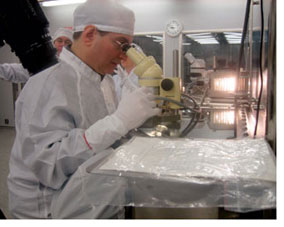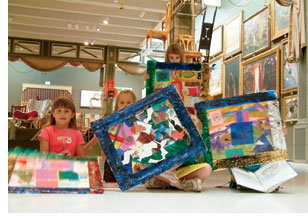Back
A thimbleful of space.
 On
January 19, Carnegie Science Center’s Dan Malerbo
(below) was among 56 science educators invited to NASA’s
Johnson Space Center in Houston, Texas, to view tiny pieces
of comets collected from space. A product of NASA’s
Stardust unmanned space mission, the particles of comet
dust—the largest of which is smaller than a grain
of sand—had just returned to earth after a seven-year,
three-billion-mile journey. On
January 19, Carnegie Science Center’s Dan Malerbo
(below) was among 56 science educators invited to NASA’s
Johnson Space Center in Houston, Texas, to view tiny pieces
of comets collected from space. A product of NASA’s
Stardust unmanned space mission, the particles of comet
dust—the largest of which is smaller than a grain
of sand—had just returned to earth after a seven-year,
three-billion-mile journey.
“
What was most thrilling was that they treated us like part
of the team,” Malerbo says, still marveling over
the experience. “All of the scientists spoke with
us, ate with us, and included us in their excitement.”
Seven
years ago, Malerbo was among 30 science educators (out
of hundreds who applied) selected by NASA to be part
of its new Solar System Educators Program. No small honor,
the program involves its members in some of NASA’s
most exciting science
expeditions—including its missions to Mars and Pluto—through
on-site visits, online training, and call-in discussions.
In return, members
like Malerbo share their training with 100 other teachers
every year.
Malerbo has been with Carnegie Science Center
for 16 years and is currently education coordinator for
the Buhl Planetarium
and the OMINMAX® theater. He also heads the Science
Center’s Astronomy Apprenticeship program and teaches
Astronomy at Community College of Allegheny County.
While
in Houston for the Stardust unveiling, Malerbo took an “air
shower” and donned the standard white “bunny
suit” before entering the clean-room environment
where the comet particles are being held. What did he see
there? “You could see some marks on the aerogel,” he
says, referring to the ultra-light material used to capture
the specks of actual comets. “There’s only
enough to fill a thimble—but that’s more than
enough for scientists to work with.” And enough,
perhaps, to unlock some of the mysteries of the solar system.
Gifts that would make Carnegie proud.
 Andrew
Carnegie relished the way his museum brought the wonders
of the natural world to the people of Pittsburgh—filling
it with dinosaurs, Egyptian mummies and the like, and making
it a home to scientists of the Earth. Fortunately, there
are still those who share his passion today. Andrew
Carnegie relished the way his museum brought the wonders
of the natural world to the people of Pittsburgh—filling
it with dinosaurs, Egyptian mummies and the like, and making
it a home to scientists of the Earth. Fortunately, there
are still those who share his passion today.
In February,
Pittsburgh business executive Richard P. Simmons announced
that the R.P. Simmons Family Fund had given Carnegie
Museum of Natural History $5 million to endow its Special
Exhibits Gallery, the new climate-controlled gallery that,
since opening in 2003, has housed Incan treasures and bog
mummies from Europe, among other special exhibits. “The
museum has, for more than a century, taught us all so much
about our world,” Simmons says. “My family
and I are so pleased to be able to play a part in ensuring
that it will be able to continue fulfilling its mission
for many years to come.” In May, the gallery will
be renamed in the Simmons family’s honor.
A few months
earlier, the directors of Colcom Foundation announced they
would give $1 million to the museum’s
Science Preservation Fund. Established in 2003 to secure
the future of the Museum of Natural History’s 10
scientific sections, the fund raised nearly $500,000 in
its first two years, surpassing its immediate goal of $300,000.
“
Colcom Foundation recognizes the value of the world-class
research conducted by Carnegie Museum of Natural History
scientists,” says Donna Panazzi, vice president of
Colcom Foundation, which was established by the late Cordelia
Scaife May. “Future discoveries and the continued
building of collections to record the history of life on
Earth are not only critical to the museum’s mission;
they benefit us all.” No doubt, Andrew Carnegie would
second that.
Something old, something
new…
 This year, at the 14th annual Antiques Show, presented
by the Women’s Committee of Carnegie Museum of Art,
expect to find a fine selection of premium antiques from
the 19th century and earlier. But expect, also, to find
first-rate objects from the 20th century, including Art
Deco, tapestries, modern art, jewelry, and outdoor items. This year, at the 14th annual Antiques Show, presented
by the Women’s Committee of Carnegie Museum of Art,
expect to find a fine selection of premium antiques from
the 19th century and earlier. But expect, also, to find
first-rate objects from the 20th century, including Art
Deco, tapestries, modern art, jewelry, and outdoor items.
Scheduled for April 6-8, the theme for this year’s
show is Rethinking Antiques, Works from the Golden
and Modern Ages. By incorporating 20th-century objects,
the committee hopes to bring a fresh new spirit to the
show
and appeal to younger collectors interested in buying pieces
that easily blend in with their up-to-the-minute lifestyles.
Special Antiques Show programs include the Benefit Preview
on April 5; a Benefit Lecture by Daphne C. Lingon, senior
vice president of Christie’s Americas, on April 6;
and a Benefit Wine Tasting on April 7. For more information
or to make reservations, call 412.622.3325, or email tabrumj@carnegiemuseums.org.
The art of being child-friendly.
 Whoever
said art museums aren’t for kids hasn’t read the March 2006
issue of Child magazine, in which editors ranked the 10 best art museums
for kids
in the country. Coming in at number five: Carnegie Museum of Art. Whoever
said art museums aren’t for kids hasn’t read the March 2006
issue of Child magazine, in which editors ranked the 10 best art museums
for kids
in the country. Coming in at number five: Carnegie Museum of Art.
“
We love welcoming kids to our galleries,” says Marilyn Russell, the
museum’s curator of education. “The energy and imagination
they bring to the experience of looking at art, making art, and talking
about
what they see is as much fun for us as it is for them.”
Child magazine
Editor-in-Chief Miriam Arond says art museums have come a long way, and
for good reason. “We all grew up with a ‘don’t
touch, don’t talk too loud’ attitude,” she says. “But
there’s a recognition now that if you don’t get children excited
about art at a young age, it’s unlikely they’ll walk in when
they’re 15 or 20 and be immediately captivated.”
Things that
captivate kids at Carnegie Museum of Art include the museum’s
free, drop-in art-making programs every weekend; its gallery play dates for
preschool-aged children; its plentiful offering of classes and summer camps
for kids of all ages; and its mascot, the irrepressible Art Cat, with his
popular audio tour of the collection.
The magazine also cited some “Don’t
Miss” activities at
the museum, such as kids’ programming planned around the upcoming exhibition
Fierce Friends: Artists and Animals, 1750–1900, opening to members
on March 25 and to the general public on March 26. Says Marilyn Russell: “I
hope this will inspire more families to come and enjoy time together in the
galleries.”
Ten years of excellent science and technology.

Hard
to believe it was a decade ago that Carnegie Science Center
announced its first Awards for Excellence winners. Since
then,
hundreds of individuals and organizations have been honored
for their accomplishments in
science and technology. “These awards reflect our
mission at Carnegie Science Center, which is to inspire
learning and curiosity by connecting science and technology
with everyday life,” says Jo Haas, The Henry Buhl,
Jr., Director of Carnegie Science Center. “They are
a celebration of our region and a tribute to the many people
who make profound contributions to the community.” Among
those supporting the awards is Eaton Corporation, which
for years has had a strong association with the Awards
for Excellence, most recently as its lead sponsor. Jerry
Whitaker, vice president, Power Control Systems Operations,
Eaton Electrical, is this year’s event chairman.
On
May 3, the following innovators will be honored at a celebration
at Carnegie Museum of Pittsburgh’s Carnegie
Music Hall: Chairman’s Award/McGowan Institute for
Regenerative Medicine; Advanced Manufacturing Award/John
J. Craig and F. Gary Kovac, Supply Systems, Inc.; Catalyst
Award/Red Whittaker, Ph.D., Robotics Institute, Carnegie
Mellon; Corporate Innovation Award/Vocollect; Entrepreneur
Award/Lawrence Rhoades, The Ex One Company; Environmental
Award/Pittsburgh Parks Conservancy; Information
Technology Award/Raul Valdes-Perez, Ph.D.; Life
Sciences Award/Savio
L-Y. Woo, Ph.D., D.Sc. (Hon.), Musculoskeletal Research
Center, Department of Bioengineering, University of Pittsburgh;
Media Award, Bayer Corporation and its Making
Science Make Sense research project and Bayer
Facts of Science Education survey; Start-up
Entrepreneur Award/Richard D. McCullough,
Ph.D., Carnegie Mellon University and Plextronics, Inc.
The following educators will also be honored: Scott Sundgren,
South Fayette Township School District; Nicholas S. Kovacic,
Greene County Career and Technology Center; Laurie R. Ahrenholtz,
North Hills School District; Jennifer, Cartier, Ph.D.,
University of Pittsburgh; and the Hopewell School District.
Birds of a very different feather.
 For
more than a century, paleontologists have debated the link
between modern birds and dinosaurs: Are they only
distant cousins, or are dinosaurs the direct ancestors
of birds? A recent discovery by Carnegie Museum of Natural
History dinosaur expert Matt Lamanna (below right) and
his colleagues is giving scientists on both sides of the
debate plenty to think about. For
more than a century, paleontologists have debated the link
between modern birds and dinosaurs: Are they only
distant cousins, or are dinosaurs the direct ancestors
of birds? A recent discovery by Carnegie Museum of Natural
History dinosaur expert Matt Lamanna (below right) and
his colleagues is giving scientists on both sides of the
debate plenty to think about.
Documented in a Science Channel special
hosted by Lamanna that premiered on February 6, the discovery
places birds
in the age of the dinosaur. Called Rise of the Feathered
Dragon, it’s a first-person account of what
Lamanna and his colleagues and fellow Penn graduates Hailu
You,
member of the Chinese Academy of Geological Sciences, and
Jerry Harris, director of Paleontology at Utah’s
Dixie State College, found at a site in northwestern China
called the Changma Basin. “The fossils we found were
actually preserved with their feathers,” explains
Lamanna, assistant curator of Vertebrate Paleontology,
who will submit a scientific paper on the finding later
this year. “Most amazingly, they are about 110 million
years old, older than any fossils of advanced birds previously
found.”
Scientists first found the remains of feathered
dinosaurs 10 years ago in quarries in the Liaoning Province
of China,
about 1,000 miles from the Changma Basin, an event that
added plenty of fuel to the bird-dinosaur evolution debate.
Stay tuned for more on the Changma Basin discoveries later
in 2006!
Back
| Top |